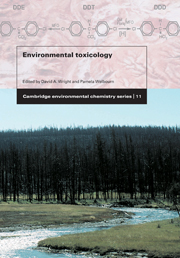Book contents
- Frontmatter
- Contents
- Foreword
- Preface
- Abbreviations
- Acknowledgements
- 1 The emergence of environmental toxicology as science
- 2 The science of environmental toxicology: Concepts and definitions
- 3 Routes and kinetics of toxicant uptake
- 4 Methodological approaches
- 5 Factors affecting toxicity
- 6 Metals and other inorganic chemicals
- 7 Organic compounds
- 8 Ionising radiation
- 9 Complex issues
- 10 Risk assessment
- 11 Recovery, rehabilitation, and reclamation
- 12 Regulatory toxicology
- 13 An overall perspective, or where to from here?
- Glossary
- Index
3 - Routes and kinetics of toxicant uptake
Published online by Cambridge University Press: 05 June 2012
- Frontmatter
- Contents
- Foreword
- Preface
- Abbreviations
- Acknowledgements
- 1 The emergence of environmental toxicology as science
- 2 The science of environmental toxicology: Concepts and definitions
- 3 Routes and kinetics of toxicant uptake
- 4 Methodological approaches
- 5 Factors affecting toxicity
- 6 Metals and other inorganic chemicals
- 7 Organic compounds
- 8 Ionising radiation
- 9 Complex issues
- 10 Risk assessment
- 11 Recovery, rehabilitation, and reclamation
- 12 Regulatory toxicology
- 13 An overall perspective, or where to from here?
- Glossary
- Index
Summary
General considerations
To gain access to an organism, toxicants must usually penetrate at least one layer of cells. A variety of rate-limiting uptake processes may be conveniently studied using unicellular organisms such as algal cells, and much has been learned about the kinetics of chemical bioaccumulation from such simple systems. However, when cells are formed into single or complex membranes, the situation rapidly becomes more complicated. Transepithelial chemical movement is now studied by comparing the external medium with a defined bodily fluid such as blood, which serves as a vector of the toxicant to internal tissues where it may be stored or metabolized. The plasma membrane of a single cell consists of a lipid bilayer containing various embedded protein molecules. Some proteins play a role in transepithelial chemical transport. Specialized carrier proteins may mediate the transport of a variety of chemicals including ions, sugars, amino acids, and several xenobiotics, and in doing so they perform a range of functions encompassing nutrition, homeostasis, excretion, and detoxification.
Other models for transepithelial chemical movement include channels, which may have specific voltage or chemical triggers controlling their opening and closing, and pores operating on the basis of molecular size exclusion. Many nonpolar xenobiotic chemicals move through the lipid portion of the plasma membrane by passive diffusion, a process that may be limited by the plasma membrane's relative lipid solubility.
Configuration of cells into complex membranes or epithelia often confers “orientation” to those cells.
- Type
- Chapter
- Information
- Environmental Toxicology , pp. 70 - 96Publisher: Cambridge University PressPrint publication year: 2002



